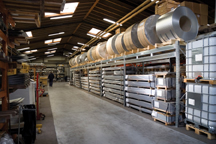
Steel Sheet Thickness Tolerances
ASTM International Committees A01 on Steel, Stainless Steel and Related Alloys and A05 on Metallic-Coated Iron and Steel Products recently approved revisions to two standards that clarify the thickness tolerances for both uncoated and coated steel sheet products. These standards are A568/A568M, Specification for Steel, Sheet, Carbon, Structural, and High-Strength, Low-Alloy, Hot-Rolled and Cold-Rolled, General Requirements for, and A924/A924M, Specification for General Requirements for Steel Sheet, Metallic-Coated by the Hot-Dip Process.
Previously, standards for these products included two sets of tolerance tables for each product, neither of which was the default. Purchasers were required to decide which set of tables applied to their purchase orders. With the approval of these standards in November 2009, all general steel sheet and product specifications have default thickness tolerance tables with limits that can be used worldwide. In the past, each set of thickness tolerance tables differed not only in tolerance limits but also in how close to the edge of the sheet these limits applied.
Thickness fall-off close to the sheet edge is a natural phenomenon that occurs during hot and cold rolling. On purchase orders the buyer was required to specify which set applied. Buyers needing to protect a minimum thickness closer to the edge generally invoked the 3/8-in. [10 mm] edge distance tables even though they have less restrictive tolerances.
Committees A01 and A05 have moved the 3/8-in. [10 mm] tables from the body of A568/A568M and A924/A924M to the Supplementary Requirements sections of these documents. The 1-in. [25 mm] edge distance tables are now the default applicable thickness tolerances unless the supplementary 3/8-inch [10 mm] tables are called out on the purchase order.
The Ordering Information section of each product specification has been revised to direct purchasers to the supplementary tables in the respective general specification.
These revisions make available thickness tolerances much clearer, as there is only one set of tables in the body of each specification. Because these tables are now the equivalent of any in the world, requests for "one-half ASTM thickness tolerance" should decline. On the other hand, users who need product purchased to the 3/8-in. [10 mm] edge distance can still obtain their requirements by invoking the Supplementary Requirements sections of the specifications.
To purchase ASTM International standards, visit www.astm.org and search by the standard designation number, or contact ASTM Customer Relations (phone: 610-832-9585).
CONTACT Technical Information: Gary Dallin, Galvinfo Center • Burlington, Ontario, Canada • Phone: 905-315-7443 • E-mail: gdallin@cogeco.ca O ASTM Staff: (A01) George Luciw • Phone: 610-832-9710; E-mail: gluciw@astm.org • (A05) Rick Lake • Phone: 610-832-9689 • E-mail: rlake@astm.org O Upcoming Meeting: (A01) May 17-20 • May Committee Week • St. Louis, Mo. • (A05) May 16-18 • May Committee Week • St. Louis, Mo.
 SN Home
SN Home Archive
Archive Advertisers
Advertisers Masthead
Masthead RateCard
RateCard Subscribe
Subscribe Email Editor
Email Editor